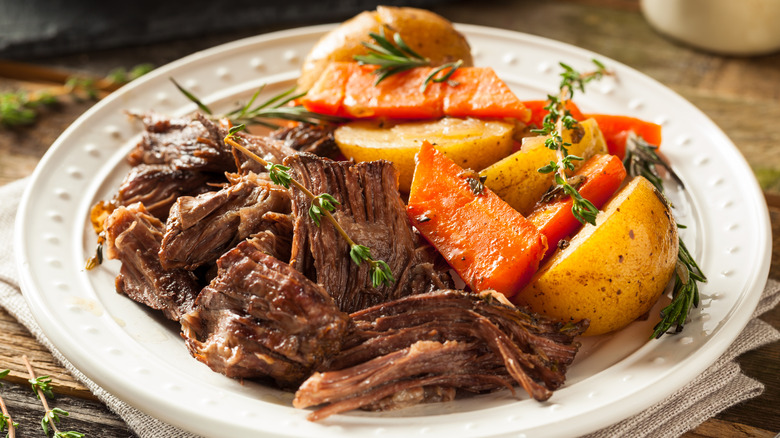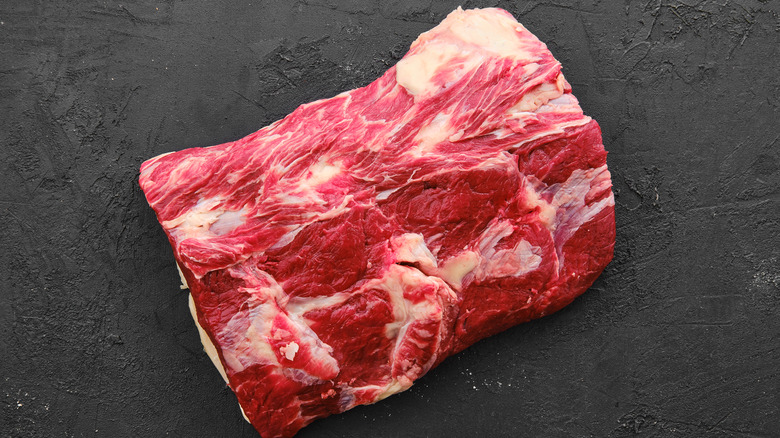The Absolute Best Cuts Of Beef To Slow Cook
With meat prices on the rise, you may find yourself looking at cheaper cuts of meat. But a lower price doesn't mean you have to spend your evening chewing on off-flavored shoe leather. A slow cooker can turn cheap but tough pieces of meat into tender, flavorful perfection. Best of all, they aren't hard to operate — simply set your slow cooker to the desired setting (low or high), cover, and simmer. Because the lid keeps the heat in, a slow cooker takes time to get back up to temperature if the top is removed often. To avoid this, you're best off leaving it alone once your meat is cooking.
We're going to look at the best cuts of beef you can use with a slow cooker. You can slow cook everything from large pieces of meat to stews and soups. Slow cookers use a method called braising, which involves cooking something partially covered in liquid at a low temperature over a long period of time. This method is ideal for getting the best out of tough cuts full of collagen, bone, and connective tissue. If done perfectly, braising will release all the flavors of the meat while making everything fork tender.
Chuck Roast
Chuck comes from the front of the cow, around the shoulder area, and is a hard-working muscle. As a result, while the chuck can be pretty tough, it comes with a rich, beefy flavor and is one of the fattier budget cuts of the cow. Don't be surprised if you spot a piece of chuck with great marbling and excellent roasting potential (via Thousand Hills Lifetime Grazed). The chuck is best cooked low and slow, leading to a tender piece of flavorful meat.
A slow cooker pot roast requires some initial prep, but the result is more than worth the effort and ideal for chuck. It would be best if you dry brine your roast for one to three days by coating it in salt and putting it in the fridge. Next, sear your roast. While this isn't an essential step, the result will heighten the meat's flavor. Your chopped vegetables can be caramelized in a pan for extra flavor, and you can also deglaze the pan with wine. Or you can just put all of the ingredients in your slow cooker; it's up to you. For liquid, pour in some wine and add a can of tomatoes to the slow cooker, making sure you have enough liquid to cover the meat completely. Cook your roast on high for two hours of cook time per pound of meat. Once the beef is fork-tender, it's ready to go. If you want a rich sauce to accompany your meal, you can reduce the cooking liquid.
Oxtail
Oxtail — the tail of a cow or veal calf — contains a lot of connective tissue, muscle fiber, and collagen, which will all toughen up under high heat. However, a low and slow cooking method will break these tough parts down, leaving you with tender and intensely flavorful pieces of beef.
As chef Heston Blumenthal explains, this meat is perfect for stewing. Oxtail appears in several cuisines around the world, including British classics like oxtail stew (via the BBC), Asian dishes like Pho Bo, and the classic Caribbean take on oxtail. Traditionally, oxtail was a cheap, throwaway cut of meat. However, these days, oxtail has undergone a culinary renaissance in recent years and can now set you back between $4 and $10 a pound or more, with half of that weight being bone. The Jamaican style of oxtail draws heavily from the communities that have previously inhabited the island, including West Africans, Indians, the British, and the Spanish. The dishes' preparation also finds its roots in African one-pot cooking traditions. (via Insider).
Rump Roast
The rump comes from the round, a cut located at the back of the cow (via Beef It's What's For Dinner). As a hard-working group of muscles used for movement, this cut can be very tough unless properly prepared. A rump roast is also quite lean, so drying the cut out is a risk if it isn't appropriately cooked. Because of the cut's toughness, leanness, and large size, the rump tends to be a pretty cheap cut of beef.
This combination of lean meat and firm texture makes rump roast ideal for your slow cooker. The low heat over a long period will break down the connective tissue and collagen inside the meat, making it more tender. Marinades and the various liquids you can cook the roast in reduce the risk of drying out the rump and adds flavor — which may make up for the lack of fat.
Eye of Round
The eye of round may look like a tenderloin, but if you try frying and eating both side by side, the difference will soon become apparent. This cheap and extremely lean cut comes from the same hard-working primal as the rump and has all the toughness you can expect from a muscle used for movement. Because of these factors, it is one of the go-to's for slow-cooked pieces of beef. This cut often makes an appearance as the roast beef you see at the deli counter (via Beef It's What's For Dinner.)
An eye of round is an excellent choice if you want to make a beef pot roast. You can also cut it into chunks, sear the outside, then use your beef cubes for stews and curries. If you have a new recipe you want to try out, the price and versatility make the eye of round an ideal choice.
Shank
One of the cheapest cuts on the cow, the beef shank (also known as beef shin), is one of the most flavorful pieces of meat you can buy. Like many bone-in cuts, it's collagen-rich and full of connective tissue. A few hours of slow cooking will leave you with a great piece of beef perfect for stews and soups. Sourced from the front or back legs of the cow, the shank has a large marrow-filled bone running through the center. The marrow and collagen will break down during cooking, giving the meat a rich flavor and producing a flavorful stock. Shanks usually come as a whole roast similar to a lamb shank, as thinner cross-cuts or a larger center cut.
You can use beef shank as an affordable substitute for veal in dishes like osso buco. The name "osso buco" actually translates to "bone with a hole" and refers to the shank cut itself. You can also use it in soup-like dishes, including Vietnamese classics like pho or something thicker like a Cajun gumbo. In addition to the meat itself, the bone contains a lot of marrow, which can add a rich flavor to the main dish or stand as a dish on its own (Via Thousand Hills Lifetime Grazed).
Brisket
If you want to make your own BBQ but don't have access to a smoker, your slow cooker is there for you. For a four-pound brisket: liquid smoke, brown sugar, and sliced tomatoes give you that deep barbecue flavor, a five-minute sear on each side provides a nice bark, and six hours in a slow cooker will give you the tender, juicy, delicious brisket you crave. A slow cooker recipe is also simpler than smoking a brisket, which requires precise timing and temperatures for the best results. With a slow cooker, once your prep work is done and your meat is in, you're best off leaving it alone.
Brisket is quite expensive. It comes from the cow's chest and is separated into two parts: the fatty point and the leaner flat (via Weber). Because of its fat content and marbling, the point produces tastier, more tender meat — as you would expect, it's the more expensive of the two cuts. The cheaper flat is more suited to thin slicing or shredding. Both parts can be purchased together as a whole brisket. The price doesn't mean getting tender brisket is easy; it still requires slow cooking on low heat to get the best from this cut. This is why a slow cooker is your best choice when using a smoker isn't an option.
Short Ribs
Short ribs are a versatile piece of meat that appear across multiple cuisines. Various Asian and European dishes are centered around the beef short rib, and ribs are also a barbecue staple. While some short rib dishes, such as grilled kalbi, don't require low and slow cooking — other rib dishes benefit from spending a long time on low heat. To achieve this result, a slow cooker is one of the best methods for short ribs, yielding tender, delicious meat that slides right off the bone.
Short ribs are from the chuck primal, hence their excellent marbling and deep beefy flavor. Like many cuts from the chuck primal, the short ribs are working muscles and require a long slow cook before turning from tough to tender. The ribs come in two styles: English style and flanken cut. The English style has one bone per short rib with the meat surrounding the length of the bone. Flanken short ribs — also described as LA style depending on their thickness (via Maangchi) — are cut across three bones with the bulk of the meat between the bones (via Lake Geneva Country Meats).
Ground chuck
Slow cookers are great for stewing meat, which means something versatile like ground beef and a slow cooker are a perfect pairing. Chilli, meat pie filling, and meat sauce are all great and easily made in your slow cooker. The slow cooker can also keep those dishes warm if you're going to a chili-cook-off, potluck, or family BBQ. A good slow cooker chili can be made by first browning your ground beef before stirring in onions and peppers. Add three cans of your preferred beans and canned tomatoes before transferring them to your slow cooker. You can either cook this chili on high for four hours or low for six to eight hours.
Ground beef comes from all over the cow, with tougher cuts and scraps usually making their way into the grinder. You can opt for ground beef that all comes from a particular primal, and ground chuck is a great choice when slow cooking. Chuck has an 80/20 meat to fat ratio, which means it will stay flavorful and juicy without being overly fatty. Pre-ground beef may not be the freshest or highest quality option, so it's essential to always buy it from a source you trust. Alternatively, you can always grind the beef yourself to ensure you have the desired cut, ensuring the freshest possible meat.








